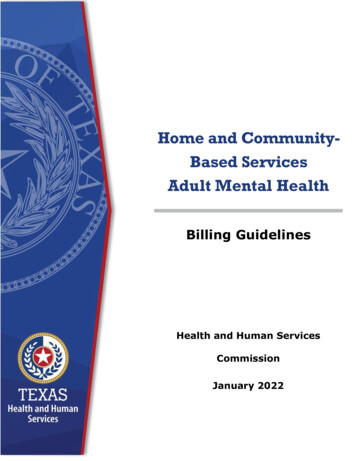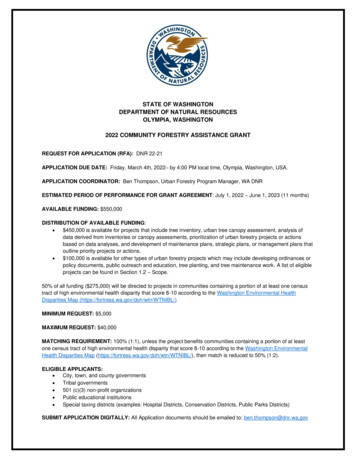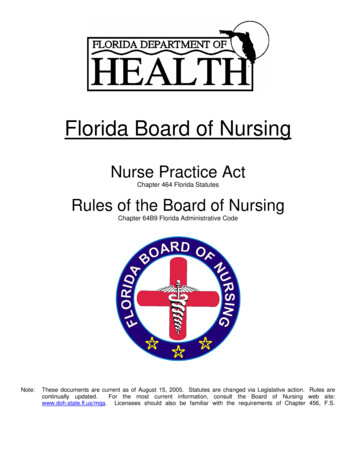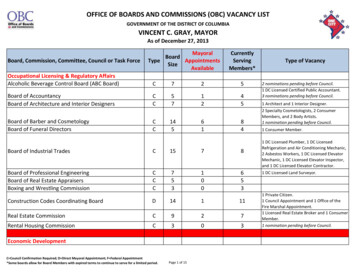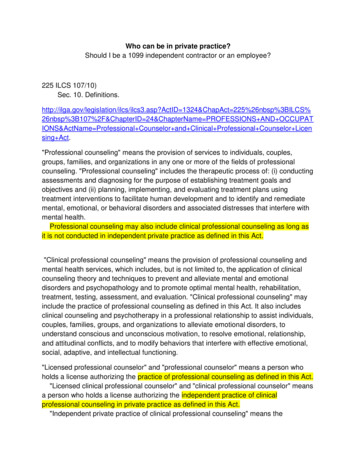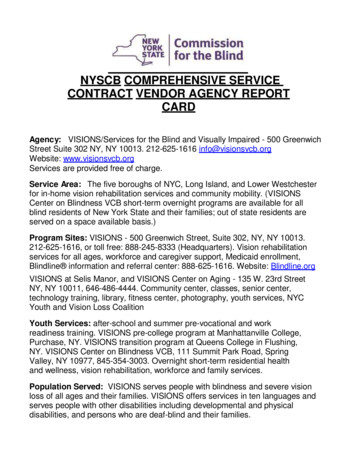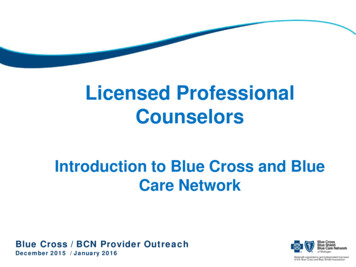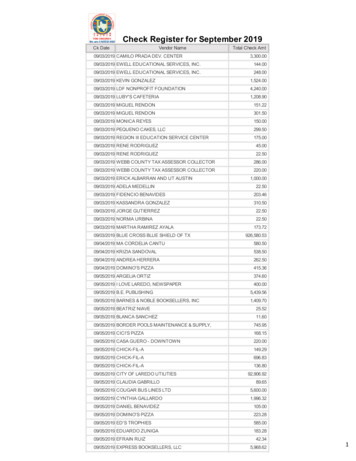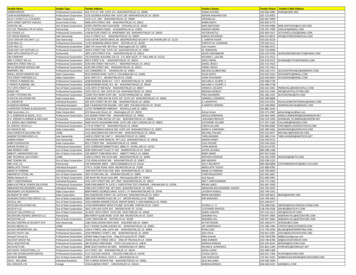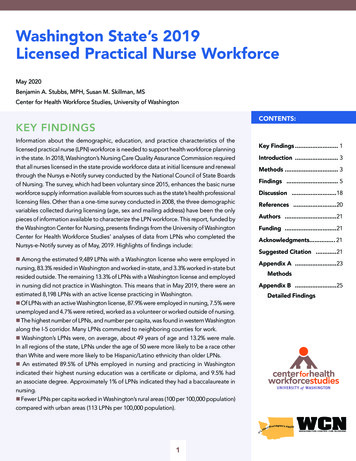
Transcription
Washington State’s 2019Licensed Practical Nurse WorkforceMay 2020Benjamin A. Stubbs, MPH, Susan M. Skillman, MSCenter for Health Workforce Studies, University of WashingtonCONTENTS:KEY FINDINGSInformation about the demographic, education, and practice characteristics of thelicensed practical nurse (LPN) workforce is needed to support health workforce planningin the state. In 2018, Washington’s Nursing Care Quality Assurance Commission requiredthat all nurses licensed in the state provide workforce data at initial licensure and renewalthrough the Nursys e-Notify survey conducted by the National Council of State Boardsof Nursing. The survey, which had been voluntary since 2015, enhances the basic nurseworkforce supply information available from sources such as the state’s health professionallicensing files. Other than a one-time survey conducted in 2008, the three demographicvariables collected during licensing (age, sex and mailing address) have been the onlypieces of information available to characterize the LPN workforce. This report, funded bythe Washington Center for Nursing, presents findings from the University of WashingtonCenter for Health Workforce Studies’ analyses of data from LPNs who completed theNursys-e-Notify survey as of May, 2019. Highlights of findings include:n Among the estimated 9,489 LPNs with a Washington license who were employed innursing, 83.3% resided in Washington and worked in-state, and 3.3% worked in-state butresided outside. The remaining 13.3% of LPNs with a Washington license and employedin nursing did not practice in Washington. This means that in May 2019, there were anestimated 8,198 LPNs with an active license practicing in Washington.n Of LPNs with an active Washington license, 87.9% were employed in nursing, 7.5% wereunemployed and 4.7% were retired, worked as a volunteer or worked outside of nursing.n The highest number of LPNs, and number per capita, was found in western Washingtonalong the I-5 corridor. Many LPNs commuted to neighboring counties for work.n Washington’s LPNs were, on average, about 49 years of age and 13.2% were male.In all regions of the state, LPNs under the age of 50 were more likely to be a race otherthan White and were more likely to be Hispanic/Latino ethnicity than older LPNs.n An estimated 89.5% of LPNs employed in nursing and practicing in Washingtonindicated their highest nursing education was a certificate or diploma, and 9.5% hadan associate degree. Approximately 1% of LPNs indicated they had a baccalaureate innursing.n Fewer LPNs per capita worked in Washington’s rural areas (100 per 100,000 population)compared with urban areas (113 LPNs per 100,000 population).1Key Findings. 1Introduction . 3Methods . 3Findings . 5Discussion .18References .20Authors .21Funding .21Acknowledgments. . 21Suggested Citation .21Appendix A .23MethodsAppendix B .25Detailed Findings
KEY FINDINGScontinuedn Statewide, 83.9% of LPNs practicing in Washington reported working full time (32hours a week or more), and of these, 11.6% reported having more than one employer.n Over 40% of LPNs reported working in long term care or hospice, the highest singlesetting category reported. Washington’s LPNs who reported having more than oneemployer (11.2% overall) were more likely to work in long term care, compared withLPNs with a single employer.The continued availability of these data will allow Washington State to consistently trackLPN workforce trends over time, providing critical information to assess changes in theLPN workforce and better anticipate education, training, practice and policy needs.2Washington State’s 2019Licensed Practical Nurse Workforce
Washington State’s 2019Licensed Practical Nurse WorkforceINTRODUCTIONPrior studies of Washington State’s licensed practical (LPN) workforce include the “Data Snapshots” conducted since 2006 by theUniversity of Washington Center for Health Workforce Studies (UW CHWS) and funded by the Washington Center for Nursing(WCN).1-9 Using data from state license records, these Snapshots have provided useful records of changes in the state and regionaldistribution and basic demographic characteristics of the LPN workforce. However, the information presented in these snapshotswas limited to licensee mailing address, birthdate and sex. With such minimal data, it was not possible to assess questions such ashow many licensed LPNs actively worked in nursing and how many held a license but did not work as a nurse, where in the statepracticing LPNs worked, in which settings they worked, the race and ethnicity of the workforce, and other information relevant tohealth workforce planning. In 2008 Washington State sponsored surveys of multiple licensed health occupations, including LPNs,which addressed many of the details needed to assess workforce supply. UW CHWS analyzed and published findings from theseone-time survey data.10 In addition, using available data at the time UW CHWS produced projections of the LPN supply anddistribution in the state.11 However resources to update these projections with newer data have not been available since that time.To collect supply data to answer fundamental questions on supply and distribution of the nursing workforce, Washington’s NursingCare Quality Assurance Commission (NCQAC) required in 2018 that all nurses licensed in the state, including LPNs, must provideworkforce data at initial licensure and renewal through the Nursys e-Notify survey conducted by the National Council of StateBoards of Nursing (NCSBN).12 For three years prior to mandatory data submission, nurses were invited to voluntarily submit datathrough the Nursys e-Notify online survey. Nurses, including those who submitted data prior to January, 2018, were asked toupdate responses, as needed, when they renewed their license.With funding from the Washington Center for Nursing, the UW CHWS conducted analyses of these data following the first fullyear of mandated data collection for LPNs, as well as for advanced registered nurse practitioners (ARNPs)13 and registered nurses(RNs).14 This report describes the results of these analyses for Washington’s LPNs.METHODSSurvey responses and a complete roster of nurses licensed in the state were downloaded from Nursys at the end of May, 2019. Welinked survey responses to the nursing roster by license number and restricted the analysis to LPNs with an active license at the endof May, 2019. This allowed us to correctly calculate the survey response rate by excluding responses from LPNs who completedthe survey at some time in the past, but later had their license transition to inactive status. As a result, this report focuses on LPNswith an active license on May 31, 2019.QUESTIONNAIREThe questions in the Nursys questionnaire were derived from the National Forum of Nursing Workforce Center’sMinimum Nurse Supply Dataset. 15 Question categories included demographics (ethnicity, race), education (initial andhighest nursing and non-nursing education), employment information (current status, hours, setting, position, specialtyand location), license status, and country initially licensed as a nurse. The online Nursys questionnaire included skip3Washington State’s 2019Licensed Practical Nurse Workforce
logic that specified that demographics and education questions were asked of all nurses and employment questionswere asked only of those who indicated they were employed in nursing.RESPONSE RATES AND SURVEY WEIGHTSThe state licensing board (NCQAC) sent multiple reminders to nurses who had not submitted their required data at licensing orrenewal. We found that 5,294 LPNs (48.7% of LPNs with active licenses in May, 2019) had completed the Nursys survey at leastonce since 2015.We compared survey respondents to all LPNs with an active Washington license based on age, sex and mailing address, theinformation provided by all nurses as part of the licensing process regardless of whether they completed the Nursys surveyquestions. We found that survey respondents were older, less likely to be male and more likely to live outside of Washingtoncompared to all licensed LPNs. Therefore, we created survey weights based on age categories, sex and mailing address locationto make survey responses more representative of all LPNs with an active Washington license. See Appendix A for further details.An online supplemental appendix16 summarizes unweighted response frequencies for each survey question, including the numbermissing.STUDY GROUP AND DATA ANALYSISAll analyses presented in this report are for LPNs with an active Washington State license on May 31, 2019. Some of the figuresand tables that follow summarize results for LPNs employed in nursing and practicing in any state. The majority summarize resultsfor LPNs employed as a nurse and practicing in Washington State.Descriptive statistics were carried out using R statistical software.17 Weighted estimates and measures of uncertainty werecalculated using the R “survey” package18 (see Appendix A for details). Percentages were calculated by excluding missing casesfor each variable (complete case analysis) and the percent missing was reported separately for each variable. The one exceptionwas the ethnicity variable. Survey respondents were asked to check a box if they identified as Hispanic/Latino. There was not acorresponding box for “Not Hispanic/Latino” or for “Choose not to answer.” Therefore it was not possible to assess the percentagemissing for the ethnicity question.CLASSIFYING RACE AND ETHNICITYFor this survey, race and ethnicity were considered to be two distinct concepts and were reported separately. Respondents couldself-identify as belonging to one or more racial category: American Indian and Alaska Native, Asian, Black or African American,Native Hawaiian and Other Pacific Islander, White, or some other race. Respondents could report multiple races. Ethnicity wasbroken into two categories separate from race: Hispanic or Latino and Not Hispanic or Latino. Hispanics/Latinos could report asany race.When summarizing race by another category (such as practice location, age or work setting), the number of individuals in thatcategory can be very small for some racial designations. While there is great interest in the distribution of nurses in each racialcategory, we consolidated all races other than White into the category “race other than White” when presenting race in many(but not all) of the tables in this report due to confidentiality concerns and our efforts to present estimates that are statisticallyvalid. “Race other than White” refers to the racial designation of the respondent and not Hispanic/Latino ethnicity. For examplea respondent could be a “race other than White” and Hispanic/Latino or a “race other than White and not Hispanic/Latino or anyother combination of the race and ethnicity categories.4Washington State’s 2019Licensed Practical Nurse Workforce
GEOGRAPHIC ASSIGNMENTUsing a data crosswalk of Washington ZIP Codes to counties, we attributed residence location to the county associated with themailing ZIP Code for the nurse’s Washington State license. Similarly, we used survey responses for LPNs employed in nursing thatindicated the ZIP Code of their primary employer to assign the county of the LPN’s primary work location. We then used countydesignations to assign LPNs to one of the state’s nine Accountable Communities of Health (ACH) healthcare planning regions19for both the residence and practice location ZIP Codes.We classified the ZIP Code in which LPNs practiced as urban or rural using the Rural-Urban Commuting Areas (RUCA) geographictaxonomy codes20 and also estimated the number of LPNs working in each county or ACH per 100,000 population based on 2018estimates of the population in each ZIP Code.21HUMAN SUBJECTSThe procedures and data protection protocols for this study were approved by the State of Washington Institutional Review BoardFINDINGSNURSES WITH WASHINGTON STATE LPN LICENSESOn May 31, 2019, there were 10,864 LPNs with an active Washington state license. An estimated 87.9% were employed in nursing,7.5% were unemployed and the remaining 4.7% were retired, worked as a nurse only as a volunteer or worked in a field otherthan nursing (Table 1).Table 1: Employment Status of LPNs with Active Washington Licenses, May 2019Estimated Statewide LPN TotalsNumber (95% CI)LPNs with an active WA licenseEmployed in nursing100%10,8649,489Column Percent (95% CI)(9,419 - 9,559)87.9%(87.2% - 88.5%)Unemployed807(752 - 863)7.5%(7.0% - 8.0%)Employed in a field other than nursing267(234 - 299)2.5%(2.2% - 2.8%)Working in nursing only as a volunteer129(107 - 152)1.2%(1.0% - 1.4%)Retired106(86 - 126)1.0%(0.8% - 1.2%)Notes: 1) LPNs could be employed in Washington or any other state. The number of active licenses is a complete count from state licensingrecords so confidence intervals do not apply. All other numbers in the table are weighted estimates, including 95% confidence intervals,based on survey responses.2) Missing survey responses: None – all survey respondents filled out the employment status question.Among unemployed LPNs, over 35% selected “Other” as the reason for being unemployed. There was not a write-in option forthis question, so it was not possible to classify these responses further. Among responses that were not in the “Other” category,the top three reasons for being unemployed were “Taking care of home and family” (29.6% of all unemployed LPNs), “School”(18.1%), “Difficulty in finding a nursing position” (11.4%) (Table 2).5Washington State’s 2019Licensed Practical Nurse Workforce
0.0%)PNsTable 2: Reason Cited by Washington’s LPNs for Being Unemployed, May 2019Estimated Statewide LPN TotalsNumber (95% CI)Reason for being unemployedColumn Percent (95% CI)Taking care of home and family236(205 - 267)29.6%(26.3% - 32.9%)School144(119 - 169)18.1%(15.3% - 20.9%)Difficulty in finding a nursing position91(72 - 110)11.4%(9.1% - 13.7%)Disabled20(11 - 29)2.5%(1.4% - 3.6%)Inadequate Salary12(5 - 19)1.5%(0.7% - 2.4%)Other294(259 - 328)36.9%(33.4% - 40.3%)Notes: 1) Only one answer was allowed for each unemployed LPN.2) 95% CI 95% Confidence Interval. Percent calculations do not include missing data.3) Missing data: 1.3% of unemployed LPNs did not answer the reason for unemployment question.Among the estimated 9,489 LPNs with a Washington license who were employed in nursing, 83.3% with a known practice addressresided in Washington and worked in-state, 0.9% resided in Oregon and practiced in Washington, 0.8% resided in Idaho andpracticed in Washington and 1.6% practiced in Washington but resided in a state other than Washington, Oregon or Idaho. (Figure1a and 1b). These figures also show that an estimated 13.3% of LPNs with a Washington license and employed in nursing didnot practice in Washington. This means that in May 2019, there were an estimated 8,198 LPNs with an active license practicingin Washington.Figure 1a: LPNs with Active Washington Licenses, May 2019Figure 1b: Residence and Practice Location Among LPNs Employed in Nursing, May 2019a.b.Residence and practice locationResidence and praamong LPNs employed in nursingamong LPNs emplo10,864(87.9%)(100.0%)9,489LPNs employednursingNumber ofinLPNs9,489(86.7%)(87.9%)8,198practicing in nursingWALPNs employed8,198 (86.7%)LPNs employed in nursingLPNs practicing in WAHave a WA license, but don'tpractice in WA (13.3%)Have a WA licepractice in WAResiding and practicing in WA(83.3%)Residing and p(83.3%)Residing in another state andpracticing in WA (1.6%)Residing in anopracticing in WAResiding in ID and practicingin WA (0.8%)Residing in ID ain WA (0.8%)Residing in OR and practicingin WA (0.9%)Residing in ORin WA (0.9%)LPNs employed in nursingNotes: 1) Residence was attributed to the state associated with the mailing ZIP Code for the LPN’s Washington State license. Practice location was based on surveyresponses for actively employed LPNs indicating the ZIP Code of their primary employer.2) Percent calculations do not include missing data. For Figure 1a, percentages are out of the total licensed in WA. For Figure 1b, percentages are out of the numberemployed in nursing.3) Missing data: Among LPNs employed in nursing, 0.4% did not fill out practice location and none were missing residence location.6Washington State’s 2019Licensed Practical Nurse Workforce
The remainder of this report will focus on the estimated 8,198 nurses actively employed as LPNs and practicing inWashington.PRACTICE LOCATIONThere was wide variation in the number of LPNs practicing in each region of the state in terms of both the estimated number ofpractitioners per 100,000 population and weighted counts based on survey responses. Figure 2 shows the estimated count andnumber of LPNs per 100,000 population practicing in each of the state’s ACH health care planning regions. The highest numberof LPNs, in both count and per 100,000 population, practiced in the Elevate Health ACH, comprised solely of Pierce County,where the state’s third most populous city, Tacoma, is located (2,168 LPNs or 244.0 LPNs per 100,000 population). HealthierHereACH (King County and containing the Seattle metro area) had the second highest estimated count of LPNs (1,728) but a relativelylow number of LPNs per 100,000 population (77.6) because this is the most populated region of the state. North Central ACH(Okanogan, Chelan, Douglas and Grant Counties) had the fewest LPNs (155 or 59.0 per 100,000 population).Figure 2: Number of LPNs per 100,000 Population (Estimated Count) Practicing in Each AccountableCommunity of Health, May 2019North Sound98.9 (1,261)North Central59.0 (155)Olympic103.6 (392)Better Health Together100.1 (614)HealthierHere77.6 (1,728)Elevate Health244.0 (2,168)Cascade Pacific Action Alliance137.4 (878)Greater Columbia86.8 (643)Southwest WA ACH68.8 (360)Notes: 1) The first number in each region is the estimated number of LPNs per 100,000 population practicing in that ACH. The estimated count practicing in each ACHis in parentheses. The map color intensity is based on the number of LPNs per 100,000 population.2) Practice location was based on survey responses for LPNs employed in nursing indicating the ZIP Code of their primary employer.3) Missing data: 0.3% missing practice location.7Washington State’s 2019Licensed Practical Nurse Workforce
LPN DEMOGRAPHICSAge - The estimated average age of Washington’s practicing LPNs was 48.5 years and the percentage of practicing LPNs in thestate who were age 55 and older was 36.6% (Table 3). Some areas of the state had an LPN workforce with a higher average age.For example, the average age of LPNs practicing in the Better Health Together ACH (Ferry, Stevens, Pend Oreille, Lincoln, Spokaneand Adams counties) was 52.0 years with 50.5% age 55 or older.Statewide, the percentage of practicing LPNs in each age category gradually increased from 7.4% in the 19-29 category to 13.8%in the 60-64 age group before dropping to 10.7% of all practicing LPNs in the 65 category (Figure 3 orange line and Table B2).Figure 3 illustrates that the age distribution varied by ACH, however. For example, Better Health Together ACH, with the highestmean age, had a low percentage of LPNs in the younger age groups and a high percentage of LPNs in older age groups. SouthwestWashington ACH had the opposite age distribution, with a high percentage in younger age groups and a low percentage in mostolder age groups, resulting in the lowest mean age of all ACHs (43.7 years).Sex - Male LPNs comprised 13.2% of LPNs practicing in-state. The percentage of LPNs who were male ranged from 10.0% inNorth Central ACH to 14.4% in Better Health Together ACH (Table 3). Close to 20% of the LPNs working in hospitals were male,compared to 7.7% of LPNs working in the ambulatory care setting (Table B1).Figure 3: Percentage of LPNs in Each Age Group in 2019, Statewide and by ACH20% 16%Greater Columbia 12% Better Health TogetherNorth CentralNorth Sound HealthierHere Statewide Olympic Cascade Pacific Action Alliance 8%Elevate Health Southwest WA ACH4%19 2930 3435 3940 4445 49Age Category50 5455 5960 6465 Notes: 1) Percent calculations do not include missing data.2) Missing data: Practice location 0.3% missing statewide.8Washington State’s 2019Licensed Practical Nurse Workforce
9Washington State’s 2019Licensed Practical Nurse Workforce26.8%(25.8% - 27.8%)6.3%(5.7% - 6.8%)13.2%(12.5% - 14.0%)36.6%(35.5% - 37.7%)48.5(48.2 - 48.8)83.9%(83.1% - 84.7%)41.3(41.1 - 41.5)11.2%(10.5% - 11.9%) PercentFull-Time( 32hours perweek) MeanHoursWorkedper Week(Full-time) Percent Workingf or 2or MoreEmployers8.4%(6.2% - 10.7%)40.7(40.0 - 41.4)86.0%(83.3% - 88.8%)9.6%(7.3% - 12.0%)11.0%(8.5% - 13.6%)4.7%(3.0% - 6.4%)14.4%(11.5% - 17.2%)50.5%(46.5% - 54.5%)52.0(51.0 - 53.0)1. BHTN 61412.2%(10.0% - 14.4%)41.5(40.9 - 42.1)81.9%(79.3% - 84.5%)35.1%(31.9% - 38.3%)12.7%(10.4% - 15.0%)6.6%(4.9% - 8.3%)10.4%(8.3% - 12.5%)35.0%(31.9% - 38.1%)48.0(47.2 - 48.9)2. CPAAN 87811.0%(9.6% - 12.4%)41.3(40.9 - 41.6)86.5%(85.0% - 88.0%)NA31.7%(29.7% - 33.8%)6.2%(5.2% - 7.3%)14.3%(12.7% - 15.9%)31.9%(29.9% - 33.9%)46.9(46.4 - 47.5)3. EHN 2,16812.6%(10.0% - 15.2%)41.9(41.2 - 42.7)83.5%(80.6% - 86.4%)16.6%(13.6% - 19.6%)17.0%(13.9% - 20.1%)15.9%(12.9% - 18.8%)11.9%(9.3% - 14.5%)44.9%(41.0% - 48.8%)51.3(50.3 - 52.3)4. GCN 64312.9%(11.3% - 14.6%)41.4(41.0 - 41.9)85.1%(83.4% - 86.8%)NA42.9%(40.4% - 45.3%)3.9%(2.9% - 4.8%)14.9%(13.1% - 16.7%)35.8%(33.5% - 38.1%)48.7(48.1 - 49.3)5. HHN 1,7289.1%(4.5% - 13.8%)40.2(38.7 - 41.7)72.9%(65.6% - 80.1%)55.2%(47.2% - 63.2%)14.9%(9.0% - 20.7%)12.6%(7.1% - 18.1%)10.0%(5.0% - 15.1%)40.2%(32.4% - 47.9%)47.1(44.7 - 49.5)6. N CentralN 15510.3%(8.6% - 12.1%)41.6(41.0 - 42.1)79.9%(77.7% - 82.2%)16.5%(14.4% - 18.7%)22.8%(20.4% - 25.3%)5.8%(4.4% - 7.1%)11.9%(10.0% - 13.8%)37.3%(34.6% - 40.0%)49.1(48.5 - 49.8)7. N SoundN 1,2617.3%(4.7% - 10.0%)40.1(39.3 - 40.8)83.6%(79.9% - 87.3%)26.9%(22.5% - 31.4%)25.3%(20.9% - 29.7%)3.1%(1.3% - 4.8%)13.4%(9.9% - 16.9%)39.5%(34.6% - 44.3%)49.6(48.4 - 50.8)8. OlympicN 39211.9%(8.5% - 15.3%)40.6(39.9 - 41.3)83.2%(79.2% - 87.1%)2.3%(0.7% - 3.9%)19.0%(14.8% - 23.2%)5.2%(2.8% - 7.5%)12.1%(8.6% - 15.6%)26.7%(22.2% - 31.2%)43.7(42.3 - 45.0)9. SWN 360Notes: 1) ) 95% CI 95% confidence interval. NA Not applicable (there were no ZIP Codes designated as rural in these ACHs).2) Race other than White was defined as all races other than White alone (including two or more races). Hispanic/Latino ethnicity was considered separately and did not factor in to the classification of race.3) Rural/Urban designation based on rural-urban commuting area codes (RUCA version 3.1) for the ZIP Code in which LPNs were employed.204) Full-time employment was defined as greater than or equal to 32 hours worked per week for all employers.5) All LPNs included in this table indicated that their primary employment was in nursing. Additional employers could have been in nursing or another field, if applicable.6) Percent calculations do not include missing data, other than for the Hispanic/Latino question. Survey respondents were asked to check a box if they identified as Hispanic/Latino. There was not a corresponding box for notHispanic/Latino” or for “Choose not to answer.” Therefore, it was not possible to assess the percentage of respondents who chose not to answer the ethnicity question.7) Counties comprising ACHs: 1) Better Health Together (BHT) includes Adams, Ferry, Lincoln, Pend Oreille, Spokane, and Stevens counties, 2) Cascade Pacific Action Alliance (CPAA) includes Cowlitz, Grays Harbor, Lewis,Mason, Pacific, Thurston, and Wahkiakum counties, 3) Elevate Health (EH) is Pierce County, 4) Greater Columbia (GC) includes Asotin, Benton, Columbia, Franklin, Garfield, Kittitas, Walla Walla, Whitman, and Yakima counties,5) HealthierHere (HH) is King County, 6) North Central (N. Central) includes Chelan, Douglas, Grant, and Okanogan counties. 7) North Sound (N. Sound) includes Snohomish, Skagit, Island, San Juan, and Whatcom counties, 8)Olympic Community of Health (Olympic) includes Clallam, Jefferson and Kitsap counties, 9) Southwest Washington (SW) includes Clark, Klickitat, and Skamania counties.8) Missing data: Practice location and rural/urban designation 0.3% missing statewide; Race 1.9% statewide, range 1.1% (HH, SW) – 5.3% GC; Highest nursing education 0.1% statewide, range 0.0% (multiple ACHs) –0.4% (HH). All other categories: No missing data for LPNs employed in nursing and practicing in WA.10.8%(10.1% - 11.4%) Percentworkingin a ruralareaWork Characteristics Raceother thanWhiteRace Hispanicor LatinoEthnicityMaleSex % 55 orolderMeanAgeStatewideAccountable Community of Health (ACH) in which LPNs practiceTable 3: Demographic and Work Characteristics of LPNs Practicing in Washington Statewide and by Accountable Community of Health, May 2019
Race and Ethnicity - Table 4 compares the race and ethnicity of the practicing LPN workforce in May, 2019 with the estimatedWashington State overall population in April, 2018.21 Based on survey responses, a lower percentage of LPNs employed in nursingand practicing in Washington identified as Hispanic/Latino compared with the overall state population. The percentage of LPNswho were Black (9.2%) wasTable 4: Hispanic/Latino Ethnicity and Racial Composition of Washington’s Practicing LPNshigher than the percentage(2019) Compared with the 2018 Washington State Overall Populationof Washington residentswho were Black (4.1%) andWashingtonLPNs practicing in WA, 2019population, 2018the percentage of WhiteN 8.198N 7,427,570LPNs was lower than theHispanic and racepercentage of Whiteidentification, amongEstimated Statewide TotalPercentresponding LPNs(95% CI)(95% CI)PercentWa s h i n g t o n re s i d e n t s .The percentage of LPNsHispanic or Latino514(468 - 559)6.3%(5.7% - 6.8%)13.0%who were a race otherRace:than White was higher inAmerican Indian orAlaska Native alone84(65 - 102)1.0%(0.8% - 1.3%)1.8%HealthierHere ACH (42.9%)and Elevate Health ACHAsian alone702(650 - 755)8.7%(8.1% - 9.4%)8.7%(31.7%), indicating that theBlack/African American alone737(683 - 791)9.2%(8.5% - 9.8%)4.1%distribution of non-WhiteNative Hawaiian orOther Pacific Islander alone71(53 - 88)0.9%(0.7% - 1.1%)0.8%practicing LPNs was notequal throughout the state.White alone5,885(5,780 - 5,989)73.2% (72.2% - 74.2%)79.5%Similarly, Greater ColumbiaOther race alone214(184 - 244)2.7% (2.3% - 3.0%)NAand North Central ACHsTwo or more races350(312 - 388)4.4% (3.9% - 4.8%)5.1%had higher percentages ofNotes: 1) 95% CI 95% Confidence Interval.Hispanic/Latino LPNs than2) Percent calculations for LPNs do not include missing data.3) Missing data for LPNs: 1.9% for race identification. Survey respondents were asked to check a box if they identified as Hispanic/Latinoother regions (Table 3).ethnicity. There was not a corresponding box for “Not Hispanic/Latino” or for “Choose not to answer.” Therefore, it was not possible toassess the percentage of missing responses for the ethnicity question.4) State population estimates from: Washington State Office of Financial Management.21EDUCATIONSurvey respondents were asked about their highest education in a nursing program and their highest education of any type.An estimated 89.5% of LPNs employed in nursing and practicing in Washington indicated their highest nursing educationwas a certificate or diploma, 9.5%Table 5: Highest Nursing Education Compared to Highest Education of Any Typeindicated they had an associatefor LPNs Practicing in Washington, May 2019degree and 1.0% indicated they had abaccalaureate from a nursing program.When considering the highest levelHighest Nursing EducationHighest Education of Any Typeof education from either a nursingColumn Percent (95% CI)]Column Percent (95% CI)]or a non-nursing program, 15.6% ofCertificate or diploma89.5%(88.8% - 90.2%)79.0%(78.1% - 80.0%)LPNs indicated they had an associateAssociate degree9.5%(8.9% - 10.2%)15.6%(14.8% - 16.4%)degree and 5.4% indicated they had aBaccalaureate1.0%(0.8% - 1.2%)5.4%(4.9% - 5.9%)baccalaureate (Table 5).Notes: 1) 95% CI 95% confidence interval. Percent calculations do not include missing data.3) Missing data: Among survey respondents who indicated they were employed in nursing and practicing in WA:Highest nursing education: 0.1%. Highest education of any type: 0.03%.10Washington State’s 2019Licensed Practical Nurse Workforce
Focusing on highest nursing education, Figure 4 shows that the percentage of LPNs who reported having an associate degree orhigher varied by geography, age, race and work setting. The ACHs with the highest percentage of LPNs with an associate degree innursing or higher were North Central (20.1%) and Greater Columbia (16.3%) (Figure 4a). LPNs less than 50 years old reported havingan associate degree or higher at rates approximately equal to or above the state average, whereas older LPNs reported havingan associate degree or higher at rates approximately equal to or below the state average (Figure 4b). Black LPNs were the leastlikely to have a nursing degree above the certificate or diploma level (7.9% of Black LPNs reported an associate degree in nursingor higher) followed by White LPNs (9.5%) (Figure 4c). When considering highest nursing education by work setting, LPNs workingin hospice and ambulatory care had the lowest rate with an associate degree or higher (7.1% and 9.4% respectively, Figure 4d).Figure 4: Among all LPNs Practicing in Washington, the Percent with an Associate Degree in Nursing or Higher byACH, Age, Race and Work Setting, 2019b. Age Categoriesa. Accountable Commu
licensed practical nurse (LPN) workforce is needed to support health workforce planning in the state. In 2018, Washington's Nursing Care Quality Assurance Commission required . LPN workforce trends over time, providing critical information to assess changes in the LPN workforce and better anticipate education, training, practice and policy .
